Criminal Law: Case Law and Analysis
VerifiedAdded on 2023/01/16
|8
|2243
|61
AI Summary
This project report provides a detailed analysis of criminal law through case law examples. It discusses the elements of crime, the application of subjective and objective approaches, and the legal consequences of criminal acts. The report also explores the principles of criminal law in relation to specific cases.
Contribute Materials
Your contribution can guide someone’s learning journey. Share your
documents today.
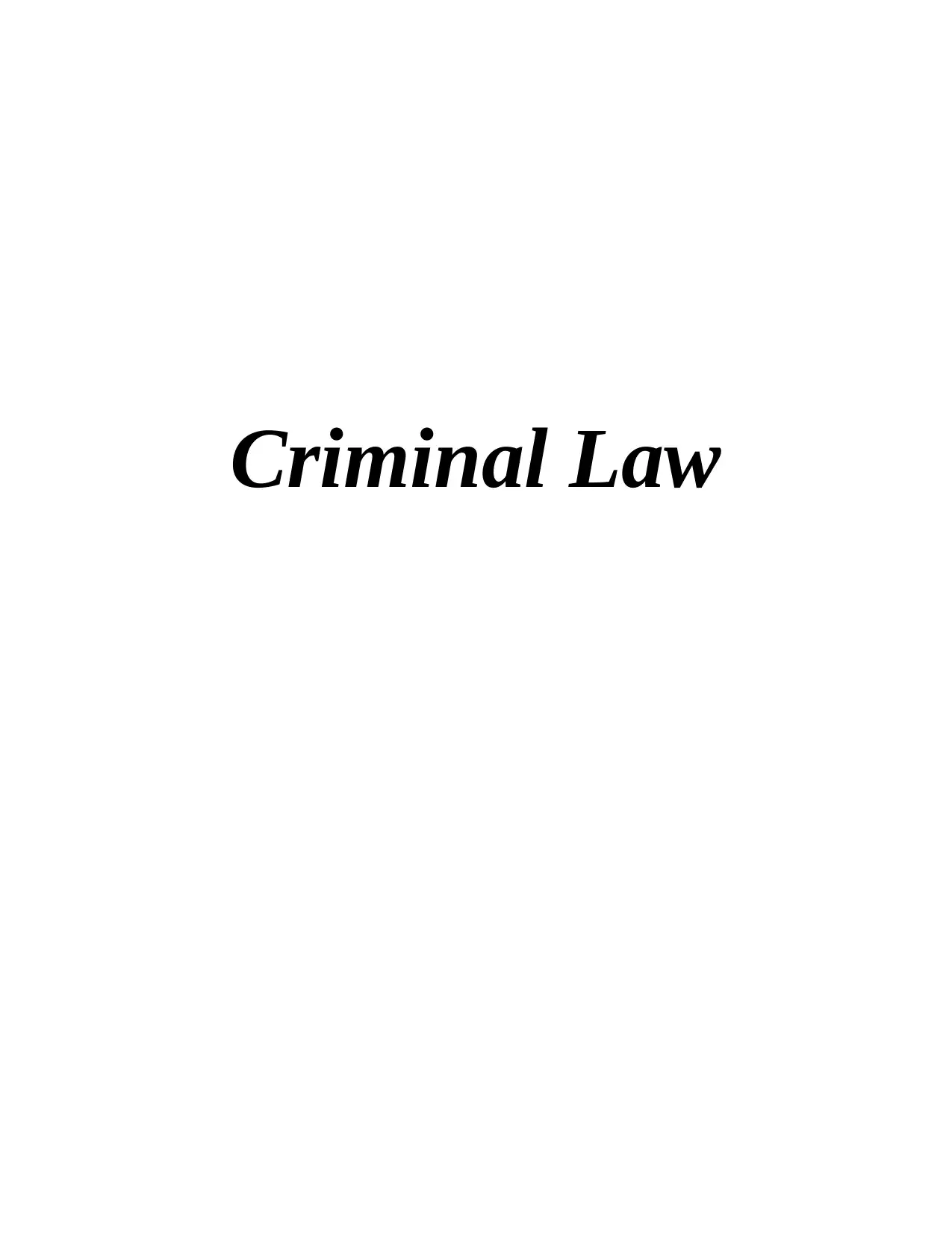
Criminal Law
Secure Best Marks with AI Grader
Need help grading? Try our AI Grader for instant feedback on your assignments.
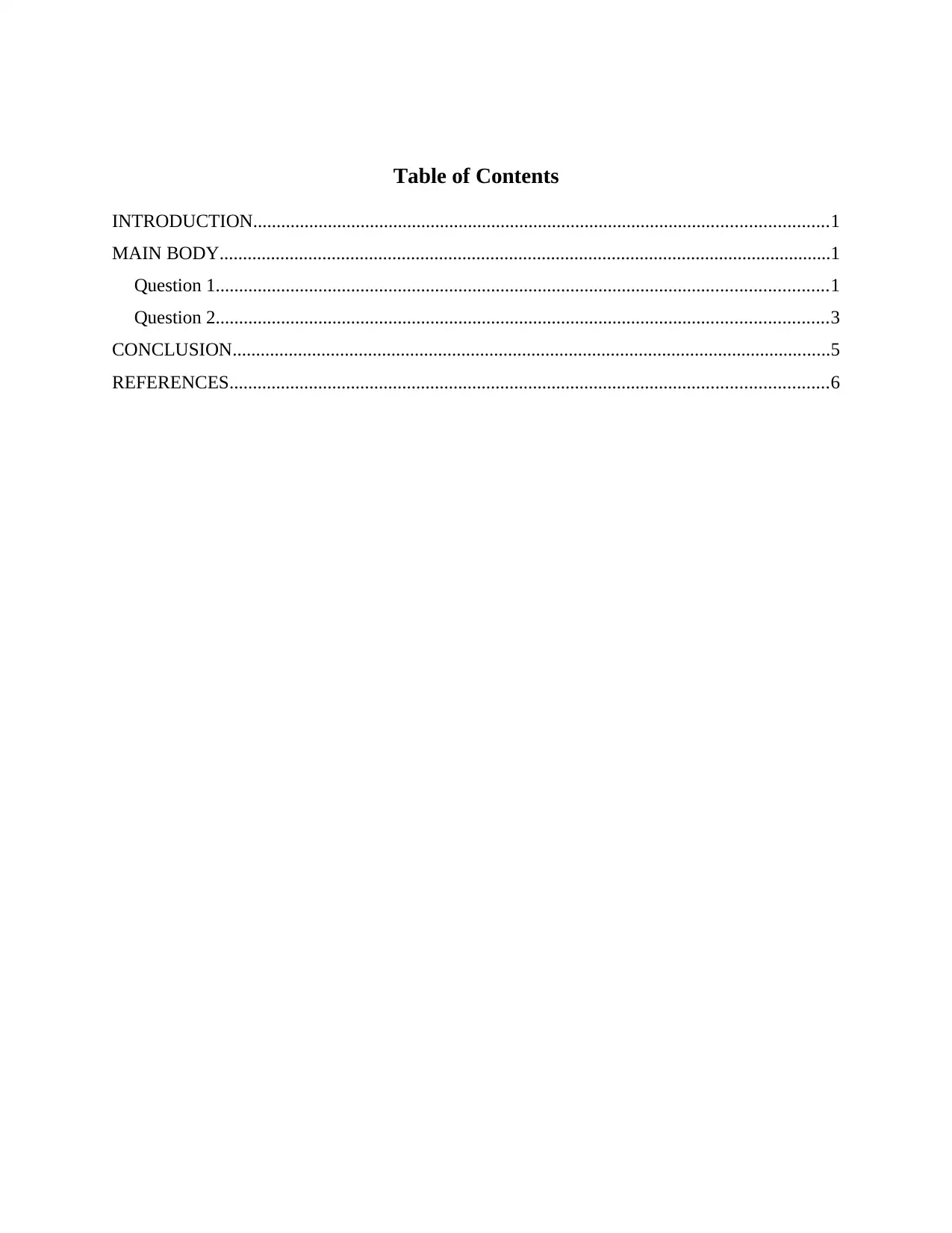
Table of Contents
INTRODUCTION...........................................................................................................................1
MAIN BODY...................................................................................................................................1
Question 1...................................................................................................................................1
Question 2...................................................................................................................................3
CONCLUSION................................................................................................................................5
REFERENCES................................................................................................................................6
INTRODUCTION...........................................................................................................................1
MAIN BODY...................................................................................................................................1
Question 1...................................................................................................................................1
Question 2...................................................................................................................................3
CONCLUSION................................................................................................................................5
REFERENCES................................................................................................................................6
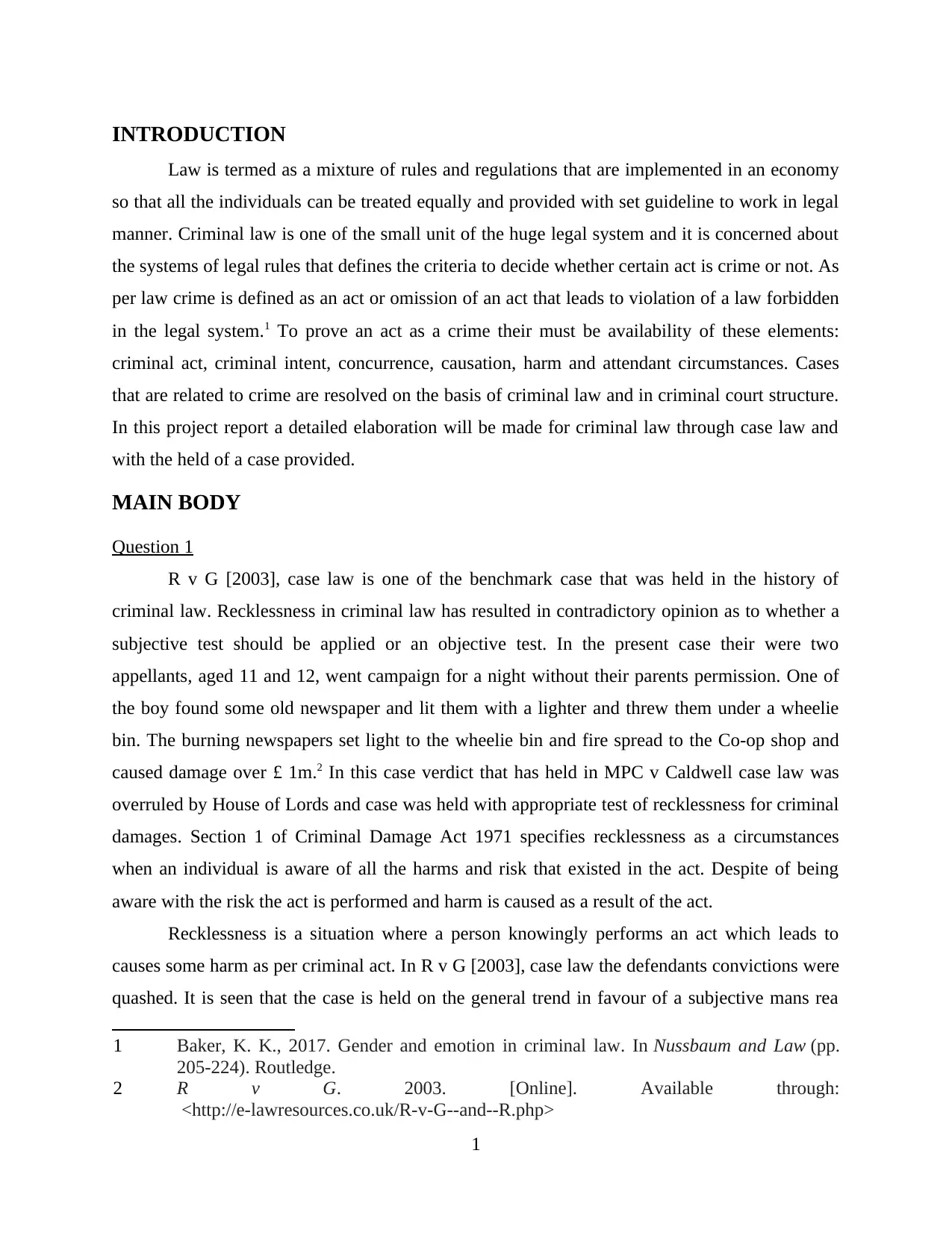
INTRODUCTION
Law is termed as a mixture of rules and regulations that are implemented in an economy
so that all the individuals can be treated equally and provided with set guideline to work in legal
manner. Criminal law is one of the small unit of the huge legal system and it is concerned about
the systems of legal rules that defines the criteria to decide whether certain act is crime or not. As
per law crime is defined as an act or omission of an act that leads to violation of a law forbidden
in the legal system.1 To prove an act as a crime their must be availability of these elements:
criminal act, criminal intent, concurrence, causation, harm and attendant circumstances. Cases
that are related to crime are resolved on the basis of criminal law and in criminal court structure.
In this project report a detailed elaboration will be made for criminal law through case law and
with the held of a case provided.
MAIN BODY
Question 1
R v G [2003], case law is one of the benchmark case that was held in the history of
criminal law. Recklessness in criminal law has resulted in contradictory opinion as to whether a
subjective test should be applied or an objective test. In the present case their were two
appellants, aged 11 and 12, went campaign for a night without their parents permission. One of
the boy found some old newspaper and lit them with a lighter and threw them under a wheelie
bin. The burning newspapers set light to the wheelie bin and fire spread to the Co-op shop and
caused damage over £ 1m.2 In this case verdict that has held in MPC v Caldwell case law was
overruled by House of Lords and case was held with appropriate test of recklessness for criminal
damages. Section 1 of Criminal Damage Act 1971 specifies recklessness as a circumstances
when an individual is aware of all the harms and risk that existed in the act. Despite of being
aware with the risk the act is performed and harm is caused as a result of the act.
Recklessness is a situation where a person knowingly performs an act which leads to
causes some harm as per criminal act. In R v G [2003], case law the defendants convictions were
quashed. It is seen that the case is held on the general trend in favour of a subjective mans rea
1 Baker, K. K., 2017. Gender and emotion in criminal law. In Nussbaum and Law (pp.
205-224). Routledge.
2 R v G. 2003. [Online]. Available through:
<http://e-lawresources.co.uk/R-v-G--and--R.php>
1
Law is termed as a mixture of rules and regulations that are implemented in an economy
so that all the individuals can be treated equally and provided with set guideline to work in legal
manner. Criminal law is one of the small unit of the huge legal system and it is concerned about
the systems of legal rules that defines the criteria to decide whether certain act is crime or not. As
per law crime is defined as an act or omission of an act that leads to violation of a law forbidden
in the legal system.1 To prove an act as a crime their must be availability of these elements:
criminal act, criminal intent, concurrence, causation, harm and attendant circumstances. Cases
that are related to crime are resolved on the basis of criminal law and in criminal court structure.
In this project report a detailed elaboration will be made for criminal law through case law and
with the held of a case provided.
MAIN BODY
Question 1
R v G [2003], case law is one of the benchmark case that was held in the history of
criminal law. Recklessness in criminal law has resulted in contradictory opinion as to whether a
subjective test should be applied or an objective test. In the present case their were two
appellants, aged 11 and 12, went campaign for a night without their parents permission. One of
the boy found some old newspaper and lit them with a lighter and threw them under a wheelie
bin. The burning newspapers set light to the wheelie bin and fire spread to the Co-op shop and
caused damage over £ 1m.2 In this case verdict that has held in MPC v Caldwell case law was
overruled by House of Lords and case was held with appropriate test of recklessness for criminal
damages. Section 1 of Criminal Damage Act 1971 specifies recklessness as a circumstances
when an individual is aware of all the harms and risk that existed in the act. Despite of being
aware with the risk the act is performed and harm is caused as a result of the act.
Recklessness is a situation where a person knowingly performs an act which leads to
causes some harm as per criminal act. In R v G [2003], case law the defendants convictions were
quashed. It is seen that the case is held on the general trend in favour of a subjective mans rea
1 Baker, K. K., 2017. Gender and emotion in criminal law. In Nussbaum and Law (pp.
205-224). Routledge.
2 R v G. 2003. [Online]. Available through:
<http://e-lawresources.co.uk/R-v-G--and--R.php>
1

approach in criminal law. Mens rea in criminal law is concerned with the state of mind of the
defendant. In criminal law approach to prove a crime is followed with a proof of mens rea. In
order to prove crime under criminal law two approaches are followed one is subjective and other
one is objective. In the present case subjective approach is followed, this approach is highly
concerned with defendants perspective and all the points that indicates that defendant can also be
guilty are overlooked in the court room.3 Objective approach which is concerned with the
perspective of the reasonable person is followed in case of MPC v Caldwell and this case law
verdict was overlooked for R v G [2003] case.
In this case the subjective approach is supported by the House of Lord and it has been
argued that this approach results in grate amount of unfair results for the owner of shop. Lord
Bingham stated that application of objective approach to all the cases will be unfair. Especially
to this case when defendants capacity to appreciate risk is inferior to others. Cases that has held
earlier using objective approach was involving defendants of the age group who are efficient and
capable to take decision with their own consciousness. In the present case defendants are two
children's of 11 years old who are not concerned with the term harm and are not aware of the fact
that what can be the results of their act.
House of Lords in this present case applied the definition of recklessness to several cases
in relation to voluntary intoxication where defendants foresight of the risk at the time of
intoxication is not investigated. The decision of the case was made on the fact that whether
defendants (11 year old children's) were aware of the risk at the time of performing the activity
to lit the old newspaper. Mens rea approach in criminal law is not justified in all the
circumstances but there are some special situation that needs to be considered. Each case have
their unique feature and verdict of two cases can not be held on the basis of decisions which has
held in the similar case in the earlier time.4
Objective approach which is followed in the criminal law cases is not unfair, instead it
leads to generation of decisions which are more accurate. Providing favour to subjective
approach in a case does not mean that subjective approach is fair or best. It just depends on the
case which approach needs to be followed so that best results can be generated. Application of
3 Daly, K., 2017. Criminal justice ideologies and practices in different voices: Some
feminist questions about justice. In Gender and Justice (pp. 437-454). Routledge.
4 Diamond, J. D., 2018. An Overview of Practicing American Indian Criminal Law in
Federal, State, and Tribal Courts, and an Update About Recent Expansion of Criminal
Jurisdiction Over Non-Indians. Federal Lawyer, April, pp.18-21.
2
defendant. In criminal law approach to prove a crime is followed with a proof of mens rea. In
order to prove crime under criminal law two approaches are followed one is subjective and other
one is objective. In the present case subjective approach is followed, this approach is highly
concerned with defendants perspective and all the points that indicates that defendant can also be
guilty are overlooked in the court room.3 Objective approach which is concerned with the
perspective of the reasonable person is followed in case of MPC v Caldwell and this case law
verdict was overlooked for R v G [2003] case.
In this case the subjective approach is supported by the House of Lord and it has been
argued that this approach results in grate amount of unfair results for the owner of shop. Lord
Bingham stated that application of objective approach to all the cases will be unfair. Especially
to this case when defendants capacity to appreciate risk is inferior to others. Cases that has held
earlier using objective approach was involving defendants of the age group who are efficient and
capable to take decision with their own consciousness. In the present case defendants are two
children's of 11 years old who are not concerned with the term harm and are not aware of the fact
that what can be the results of their act.
House of Lords in this present case applied the definition of recklessness to several cases
in relation to voluntary intoxication where defendants foresight of the risk at the time of
intoxication is not investigated. The decision of the case was made on the fact that whether
defendants (11 year old children's) were aware of the risk at the time of performing the activity
to lit the old newspaper. Mens rea approach in criminal law is not justified in all the
circumstances but there are some special situation that needs to be considered. Each case have
their unique feature and verdict of two cases can not be held on the basis of decisions which has
held in the similar case in the earlier time.4
Objective approach which is followed in the criminal law cases is not unfair, instead it
leads to generation of decisions which are more accurate. Providing favour to subjective
approach in a case does not mean that subjective approach is fair or best. It just depends on the
case which approach needs to be followed so that best results can be generated. Application of
3 Daly, K., 2017. Criminal justice ideologies and practices in different voices: Some
feminist questions about justice. In Gender and Justice (pp. 437-454). Routledge.
4 Diamond, J. D., 2018. An Overview of Practicing American Indian Criminal Law in
Federal, State, and Tribal Courts, and an Update About Recent Expansion of Criminal
Jurisdiction Over Non-Indians. Federal Lawyer, April, pp.18-21.
2
Paraphrase This Document
Need a fresh take? Get an instant paraphrase of this document with our AI Paraphraser
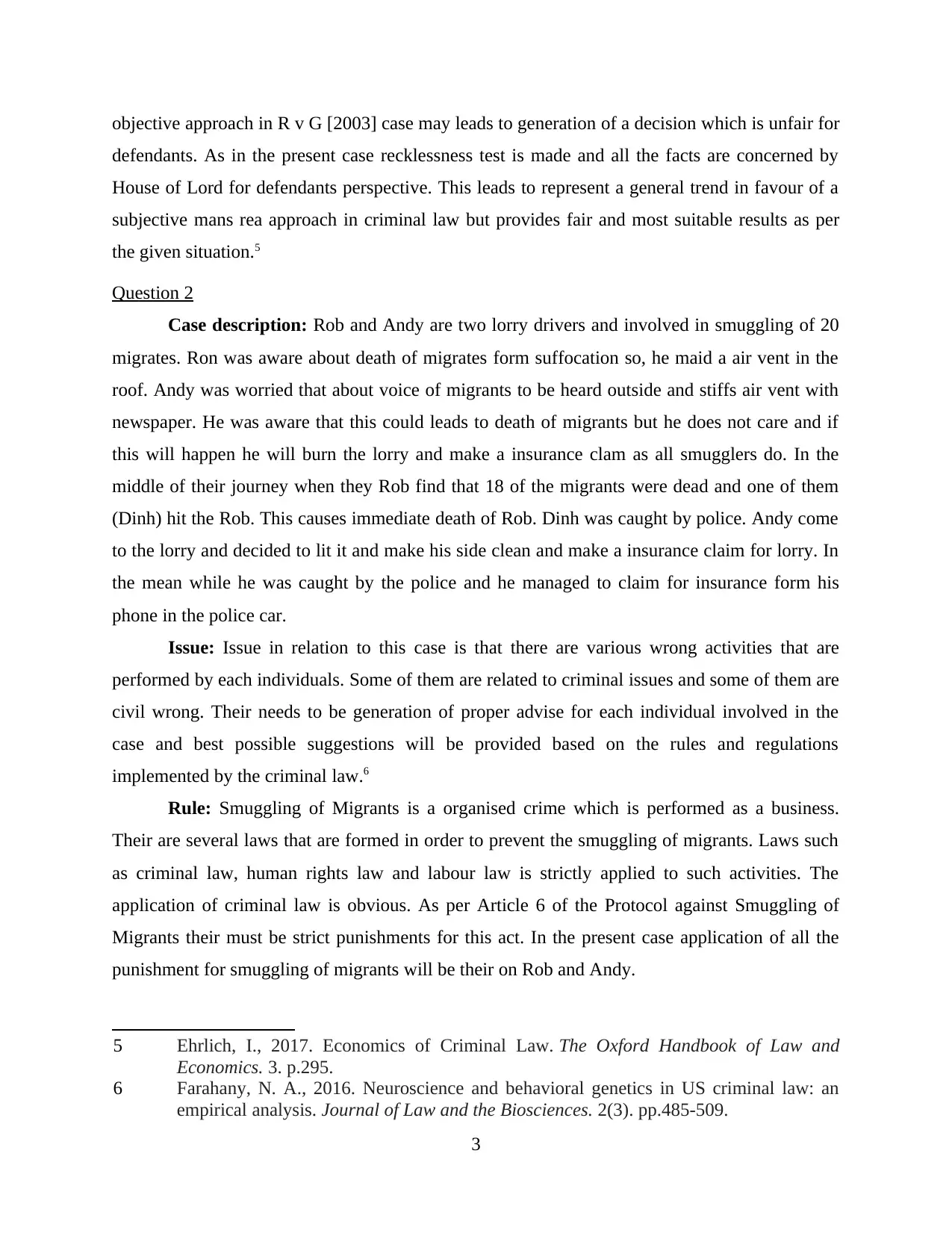
objective approach in R v G [2003] case may leads to generation of a decision which is unfair for
defendants. As in the present case recklessness test is made and all the facts are concerned by
House of Lord for defendants perspective. This leads to represent a general trend in favour of a
subjective mans rea approach in criminal law but provides fair and most suitable results as per
the given situation.5
Question 2
Case description: Rob and Andy are two lorry drivers and involved in smuggling of 20
migrates. Ron was aware about death of migrates form suffocation so, he maid a air vent in the
roof. Andy was worried that about voice of migrants to be heard outside and stiffs air vent with
newspaper. He was aware that this could leads to death of migrants but he does not care and if
this will happen he will burn the lorry and make a insurance clam as all smugglers do. In the
middle of their journey when they Rob find that 18 of the migrants were dead and one of them
(Dinh) hit the Rob. This causes immediate death of Rob. Dinh was caught by police. Andy come
to the lorry and decided to lit it and make his side clean and make a insurance claim for lorry. In
the mean while he was caught by the police and he managed to claim for insurance form his
phone in the police car.
Issue: Issue in relation to this case is that there are various wrong activities that are
performed by each individuals. Some of them are related to criminal issues and some of them are
civil wrong. Their needs to be generation of proper advise for each individual involved in the
case and best possible suggestions will be provided based on the rules and regulations
implemented by the criminal law.6
Rule: Smuggling of Migrants is a organised crime which is performed as a business.
Their are several laws that are formed in order to prevent the smuggling of migrants. Laws such
as criminal law, human rights law and labour law is strictly applied to such activities. The
application of criminal law is obvious. As per Article 6 of the Protocol against Smuggling of
Migrants their must be strict punishments for this act. In the present case application of all the
punishment for smuggling of migrants will be their on Rob and Andy.
5 Ehrlich, I., 2017. Economics of Criminal Law. The Oxford Handbook of Law and
Economics. 3. p.295.
6 Farahany, N. A., 2016. Neuroscience and behavioral genetics in US criminal law: an
empirical analysis. Journal of Law and the Biosciences. 2(3). pp.485-509.
3
defendants. As in the present case recklessness test is made and all the facts are concerned by
House of Lord for defendants perspective. This leads to represent a general trend in favour of a
subjective mans rea approach in criminal law but provides fair and most suitable results as per
the given situation.5
Question 2
Case description: Rob and Andy are two lorry drivers and involved in smuggling of 20
migrates. Ron was aware about death of migrates form suffocation so, he maid a air vent in the
roof. Andy was worried that about voice of migrants to be heard outside and stiffs air vent with
newspaper. He was aware that this could leads to death of migrants but he does not care and if
this will happen he will burn the lorry and make a insurance clam as all smugglers do. In the
middle of their journey when they Rob find that 18 of the migrants were dead and one of them
(Dinh) hit the Rob. This causes immediate death of Rob. Dinh was caught by police. Andy come
to the lorry and decided to lit it and make his side clean and make a insurance claim for lorry. In
the mean while he was caught by the police and he managed to claim for insurance form his
phone in the police car.
Issue: Issue in relation to this case is that there are various wrong activities that are
performed by each individuals. Some of them are related to criminal issues and some of them are
civil wrong. Their needs to be generation of proper advise for each individual involved in the
case and best possible suggestions will be provided based on the rules and regulations
implemented by the criminal law.6
Rule: Smuggling of Migrants is a organised crime which is performed as a business.
Their are several laws that are formed in order to prevent the smuggling of migrants. Laws such
as criminal law, human rights law and labour law is strictly applied to such activities. The
application of criminal law is obvious. As per Article 6 of the Protocol against Smuggling of
Migrants their must be strict punishments for this act. In the present case application of all the
punishment for smuggling of migrants will be their on Rob and Andy.
5 Ehrlich, I., 2017. Economics of Criminal Law. The Oxford Handbook of Law and
Economics. 3. p.295.
6 Farahany, N. A., 2016. Neuroscience and behavioral genetics in US criminal law: an
empirical analysis. Journal of Law and the Biosciences. 2(3). pp.485-509.
3

Migrates suffers form one of the basic right that constitution has provided to each citizen
is right to equality. As a migrate an individual is deprived form various rights that law provides
but no individual can be deprived form right to justice and death of migrates is unavoidable. Rob
and Andy was performing act of caring migrates and in the meanwhile migrates died because of
suffocation.7 Rob made a air vent in the lorry but his act of being humble as a human being will
not set him aside form charged as a criminal as a murderer of 18 migrates. Both Rob and Andy
will be blamed for the death of migrates in the criminal law and will be provided with all the
appropriate punishments.
Andy was the one who stuffed the air vent of the lorry and was not concerned with the
life of all migrates. Despite of knowing all the facts that death can occur through suffocation he
do not provide any concern. He was only concerned about insurance claim that needs to be maid
in any unforeseen circumstances. When he find all the dead bodies in the lorry he plained to burn
all of them and make required claim for lorry as insurance.8
Dinh as a migrate was deprived form various rights that are provided in the law. Rob and
Andy has done an act with him which leads to causes death but this does not provide him
permission to act in some aggressive manner that leads to cause death of Rob and Andy. Dinh
being a migrate will also be eligible for punishment for an act which leads to cause death of Rob.
In both the cases all the elements that make an activity crime is available. So, Dinh and
Andy both with be termed as criminals as per law and provided with punishments concerning
various sections applicable on such cases.
Insurance claim made by Andy was a dishonest claim as in the present as claims for
insurance are eligible when incidence which causes damage to the lorry has taken place.9
Application: Andy and Dinh both will be termed on the basis of section 1 of Criminal act
1900 and Criminal Code Act 2002 of Australia. Recklessness is present in both the cases and act
was performed by both the parties after knowing all the analysed results.
Claim made by Andy for insurance will be regulated as per Insurance Act, 1973. As per
this act no individual is allowed to make false claim for the incidences that has not happened yet.
7 Law, C., 2017. Assessing their Contribution to International Criminal Law (TMC
Asser. Journal of International Criminal Justice. 15. pp.1049-1055.
8 Quinney, R. and Shelden, R. G., 2018. Critique of the legal order: Crime control in
capitalist society. Routledge.
9 Robinson, P. H., 2017. A Functional Analysis of Criminal Law. In The Structure and
Limits of Criminal Law (pp. 175-232). Routledge.
4
is right to equality. As a migrate an individual is deprived form various rights that law provides
but no individual can be deprived form right to justice and death of migrates is unavoidable. Rob
and Andy was performing act of caring migrates and in the meanwhile migrates died because of
suffocation.7 Rob made a air vent in the lorry but his act of being humble as a human being will
not set him aside form charged as a criminal as a murderer of 18 migrates. Both Rob and Andy
will be blamed for the death of migrates in the criminal law and will be provided with all the
appropriate punishments.
Andy was the one who stuffed the air vent of the lorry and was not concerned with the
life of all migrates. Despite of knowing all the facts that death can occur through suffocation he
do not provide any concern. He was only concerned about insurance claim that needs to be maid
in any unforeseen circumstances. When he find all the dead bodies in the lorry he plained to burn
all of them and make required claim for lorry as insurance.8
Dinh as a migrate was deprived form various rights that are provided in the law. Rob and
Andy has done an act with him which leads to causes death but this does not provide him
permission to act in some aggressive manner that leads to cause death of Rob and Andy. Dinh
being a migrate will also be eligible for punishment for an act which leads to cause death of Rob.
In both the cases all the elements that make an activity crime is available. So, Dinh and
Andy both with be termed as criminals as per law and provided with punishments concerning
various sections applicable on such cases.
Insurance claim made by Andy was a dishonest claim as in the present as claims for
insurance are eligible when incidence which causes damage to the lorry has taken place.9
Application: Andy and Dinh both will be termed on the basis of section 1 of Criminal act
1900 and Criminal Code Act 2002 of Australia. Recklessness is present in both the cases and act
was performed by both the parties after knowing all the analysed results.
Claim made by Andy for insurance will be regulated as per Insurance Act, 1973. As per
this act no individual is allowed to make false claim for the incidences that has not happened yet.
7 Law, C., 2017. Assessing their Contribution to International Criminal Law (TMC
Asser. Journal of International Criminal Justice. 15. pp.1049-1055.
8 Quinney, R. and Shelden, R. G., 2018. Critique of the legal order: Crime control in
capitalist society. Routledge.
9 Robinson, P. H., 2017. A Functional Analysis of Criminal Law. In The Structure and
Limits of Criminal Law (pp. 175-232). Routledge.
4

Together with this insurance act do not allow claim for acts that are performed intentionally. So,
Andy will not be made eligible to claim any damages.10
CONCLUSION
From the above project report of criminal law, it has been concluded that to apply
criminal law on an individual crime needs to be proved at the first step. Their are several cases
that has held in the history of criminal law but the verdict of one case can be overruled over
other. This is because facts of each case on which decisions are taken varies for each case. While
deciding case in the justice system each facts needs to be concerned. Decision of one case can
not be judged for other and termed as unjust or unfair. All the acts which proves existence of
elements of crime will be treated under criminal law and provided with appropriate solutions as
per criminal law.
10 Stuart, D. and Coughlan, S., 2018. Learning Canadian criminal law.
5
Andy will not be made eligible to claim any damages.10
CONCLUSION
From the above project report of criminal law, it has been concluded that to apply
criminal law on an individual crime needs to be proved at the first step. Their are several cases
that has held in the history of criminal law but the verdict of one case can be overruled over
other. This is because facts of each case on which decisions are taken varies for each case. While
deciding case in the justice system each facts needs to be concerned. Decision of one case can
not be judged for other and termed as unjust or unfair. All the acts which proves existence of
elements of crime will be treated under criminal law and provided with appropriate solutions as
per criminal law.
10 Stuart, D. and Coughlan, S., 2018. Learning Canadian criminal law.
5
Secure Best Marks with AI Grader
Need help grading? Try our AI Grader for instant feedback on your assignments.
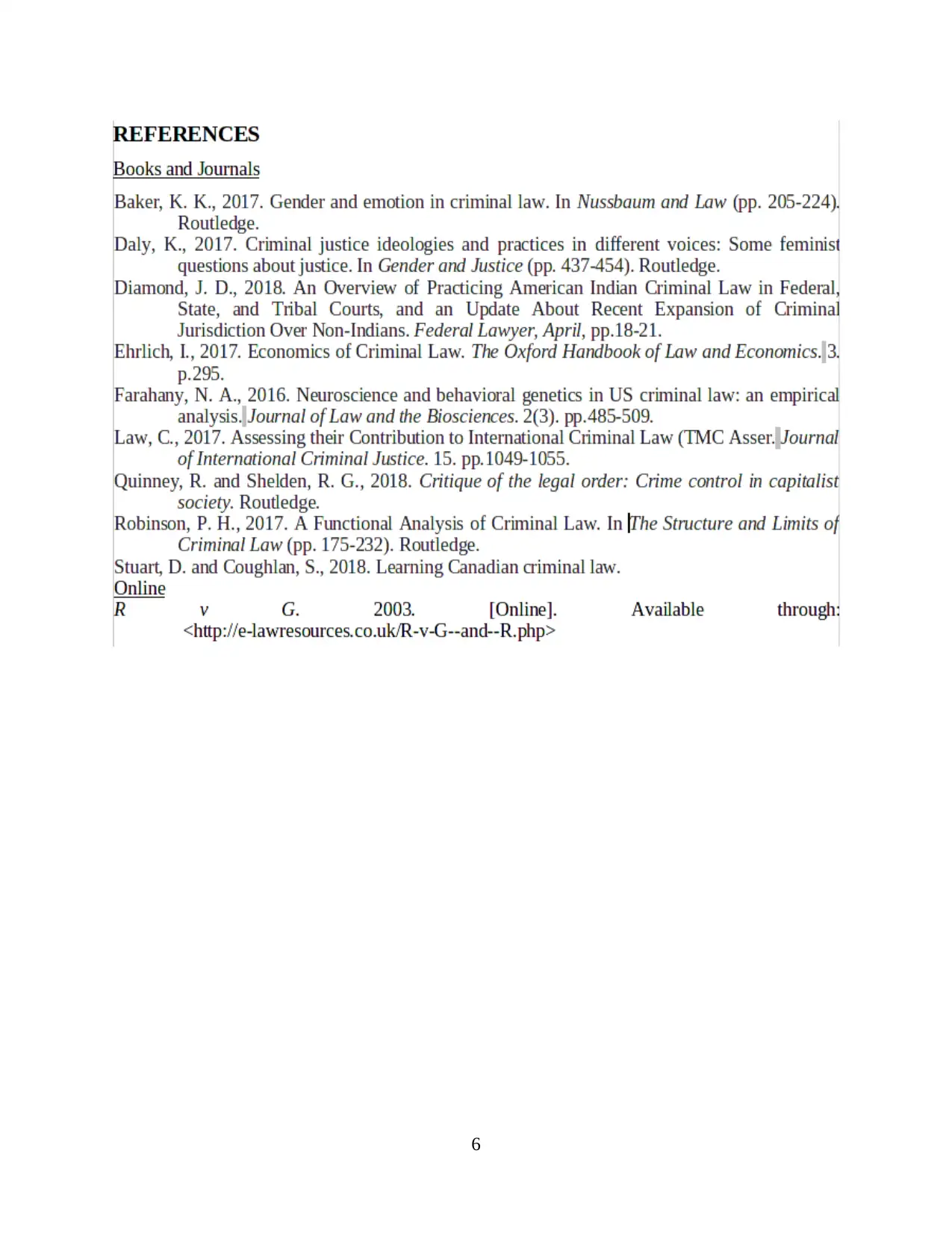
6
1 out of 8
![[object Object]](/_next/static/media/star-bottom.7253800d.svg)





